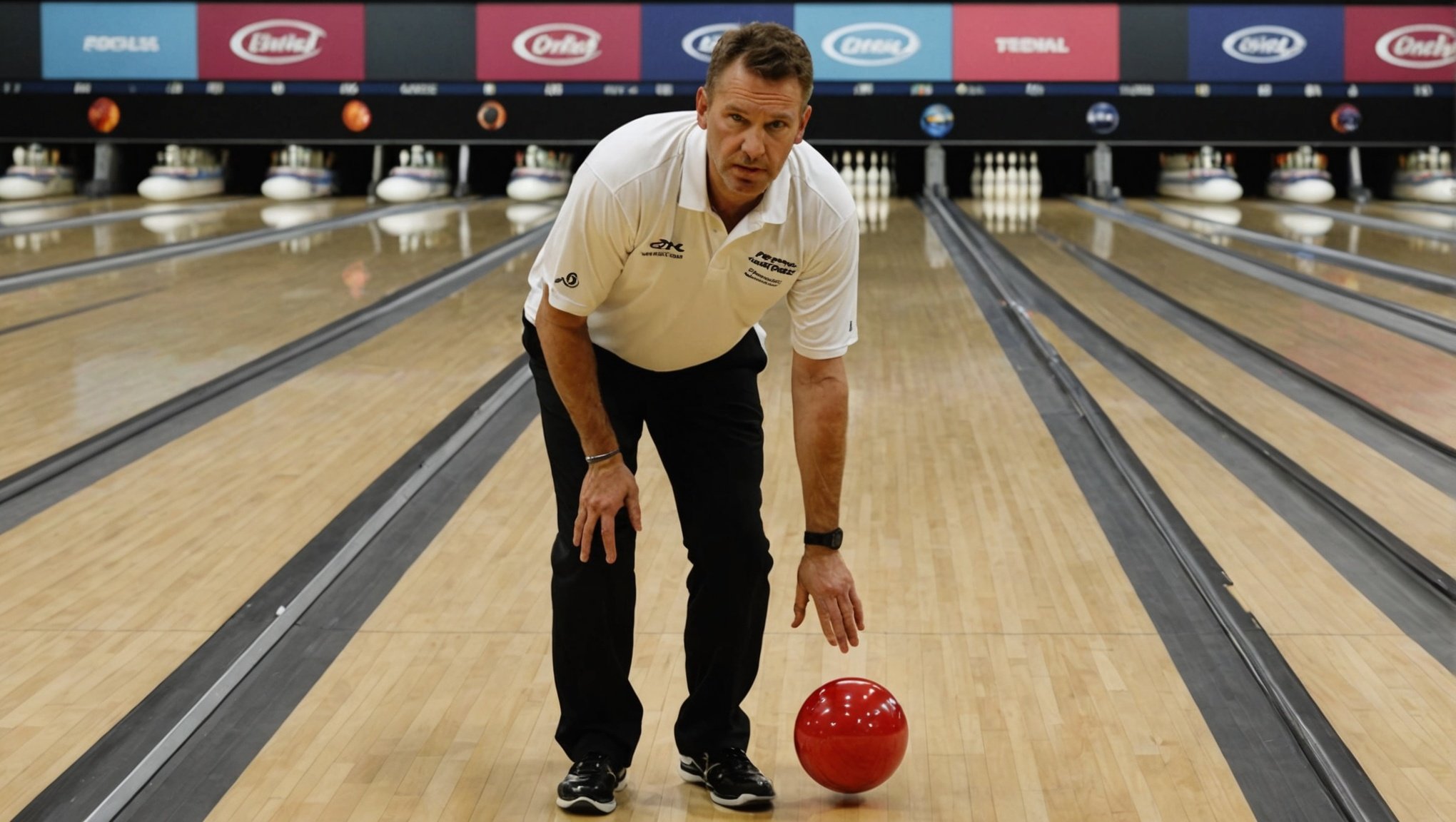Mastering the Lanes: Essential Technique Adjustments for Professional Bowlers Facing Diverse Conditions
Understanding the Dynamics of Lane Conditions
When it comes to bowling, the lane conditions can be as unpredictable as the weather. Professional bowlers know that adapting to these conditions is crucial for maintaining a high level of performance. Here’s a deep dive into how lane conditions impact your game and what adjustments you can make to stay on top.
The Role of Oil Patterns
Lane conditions are largely determined by the oil patterns applied to the lanes. These patterns can vary significantly, from the short and slick to the long and oily. For instance, a 33-foot oil pattern, commonly used in tournaments, requires a different approach compared to a 48-foot pattern[2].
Have you seen this : Mastering Safe Lifting: Essential Techniques for Powerlifters to Avoid Injuries
- Short Oil Patterns: These patterns demand a stronger ball reaction to compensate for the lack of oil. Bowlers often use balls with stronger coverstocks and more aggressive layouts to create the necessary hook.
- Long Oil Patterns: On the other hand, longer patterns require a more controlled ball motion. Here, bowlers might opt for balls with weaker coverstocks and less aggressive layouts to avoid over-hooking.
Adjusting Ball Speed and Release
Ball speed and release technique are vital components in navigating different lane conditions. Here are some key adjustments to consider:
-
Ball Speed: Controlling ball speed is essential. For example, on oily lanes, a slower ball speed can help the ball to hook more, while on drier lanes, a faster ball speed can prevent the ball from hooking too early[3].
This might interest you : Maximizing Training Efficiency: Strategies for Professional Cyclists Competing in Multi-Stage Races
-
Practice Tip: Use a ball speed trainer to fine-tune your release. These trainers simulate the feel of releasing a bowling ball, allowing you to practice your technique off the lanes[1].
-
Release Technique: The release technique can significantly impact the ball’s motion. A stronger release will result in more hook, while a weaker release will produce a straighter shot.
-
Expert Advice: “The key is to find a release that works for you and then adjust it based on the lane conditions,” says Chris Sloan, a PBA bowler. “For two-handed bowlers, maintaining hip alignment and posture is crucial for a consistent release”[4].
Fine-Tuning Your Physical Game
The physical aspect of bowling is just as important as the mental. Here’s how you can refine your physical game to adapt to various conditions.
Footwork and Body Positioning
Proper footwork and body positioning are the foundation of a consistent bowling game.
-
Footwork: The approach to the foul line should be smooth and consistent. For two-handed bowlers, it’s important to keep the hips centered and avoid collapsing during the steps. This ensures better energy transfer and precision[4].
-
Practice Drill: Practice your approach without a ball to focus on your footwork and body positioning. This will help you develop muscle memory and improve your consistency.
-
Body Positioning: Maintaining a tall, stable stance is crucial until the ball is released. This prevents energy from dissipating too early and ensures a smooth, consistent release.
-
Tip from Chris Sloan: “Staying tall while approaching the release is crucial. It prevents energy from dissipating too early and helps in maintaining a consistent shot”[4].
Choosing the Right Ball Layout
The ball layout can significantly impact how your ball reacts on different lane conditions.
- Pin Placement: Pin placement acts like the steering wheel of your bowling ball. A higher pin placement typically results in more flare, making the ball hook more once it hits the lane. Conversely, a lower pin placement offers a smoother, more controlled motion[4].
- Example: If you’re bowling on a lane with a strong oil pattern, you might opt for a ball with a lower pin placement to avoid over-hooking.
Mastering the Mental Game
The mental aspect of bowling is often overlooked but is equally important as the physical and technical aspects.
Focus and Concentration
Maintaining focus and concentration is key to performing under pressure.
- Mental Preparation: Before each shot, take a moment to focus on your breathing and clear your mind. Visualize the ball hitting the pins and imagine the perfect shot.
- Tip from a Pro: “Mental preparation is crucial. I always take a deep breath before each shot and visualize the ball hitting the pins. It helps me stay focused and calm under pressure,” says a professional bowler.
Handling Pressure and Failure
Bowling, like any sport, involves pressure and failure. Here’s how you can handle these challenges mentally.
-
Positive Self-Talk: Encourage yourself with positive affirmations. Instead of dwelling on mistakes, focus on what you can do better next time.
-
Example: After a bad shot, tell yourself, “That was just one shot. I can do better next time.”
-
Learning from Mistakes: Analyze your mistakes and use them as learning opportunities. Understand what went wrong and how you can improve.
-
Coach’s Advice: “Mistakes are part of the game. The key is to learn from them and move forward. Don’t let one bad shot affect your entire game,” advises a bowling coach.
Advanced Techniques for Diverse Conditions
Here are some advanced techniques that professional bowlers use to adapt to diverse lane conditions.
The Backup Ball Technique
The backup ball technique is a controversial but effective method for navigating challenging lane conditions.
- When to Use: This technique is particularly useful when facing tough or overplayed oil patterns. By reversing the typical ball path, you can bypass hang spots and carry-down, offering a fresh angle of attack[4].
- Example: If right-side shots aren’t working due to broken-down oil patterns, switching to a backup ball can help you navigate fresher parts of the lane on the left side.
Utilizing Different Ball Motions
Understanding the three phases of ball motion can help you fine-tune your game for different conditions.
- Phase 1: Skid Phase – The ball skids down the lane before it starts to hook.
- Phase 2: Hook Phase – The ball starts to hook as it encounters the oil pattern.
- Phase 3: Roll Phase – The ball transitions into a rolling motion as it loses energy.
By adjusting factors such as ball surface, speed, release, and lane reading, you can influence how long each phase lasts and when each phase begins and ends[2].
Practical Insights and Actionable Advice
Here are some practical tips and actionable advice to help you improve your game:
Key Takeaways for Bowlers
- Focus on Stance and Movement: Your setup, including foot positioning and hip alignment, lays the foundation for a stable and consistent release. Spend time refining these aspects to improve consistency[4].
- Adapt Ball Layouts: Different lane conditions call for varied ball layouts. By understanding pin placements and layout strengths, you can customize your arsenal for optimal performance[4].
- Utilize the Backup Ball: This technique is gaining popularity for a reason. It’s a useful tool to navigate tricky patterns, offering fresh angles of attack and keeping your game adaptable[4].
Detailed Practice Plan
Here’s a detailed practice plan to help you sharpen your skills:
-
Warm-Up (10-15 minutes):
-
Light stretching to loosen up your muscles.
-
Short practice shots to get a feel for the lane conditions.
-
Footwork and Body Positioning Drills (20-30 minutes):
-
Practice your approach without a ball to focus on footwork and body positioning.
-
Use a mirror or record yourself to analyze your stance and movement.
-
Ball Speed and Release Practice (20-30 minutes):
-
Use a ball speed trainer to fine-tune your release technique.
-
Practice different release strengths to see how they affect the ball’s motion.
-
Mental Preparation (10-15 minutes):
-
Take time to focus on your breathing and clear your mind.
-
Visualize the ball hitting the pins and imagine the perfect shot.
Mastering the lanes in bowling is a continuous process that requires a combination of physical skill, mental toughness, and technical knowledge. By understanding the dynamics of lane conditions, fine-tuning your physical game, mastering the mental game, and utilizing advanced techniques, you can adapt to any condition and improve your overall performance.
Final Thoughts from a Pro
“Bowling is a game of adjustments. The key is to stay flexible and adapt to the conditions. Whether it’s adjusting your ball speed, release technique, or mental approach, every small change can make a big difference in your game,” says Chris Sloan.
By following these tips and continuously practicing, you can elevate your bowling game to the next level and become a more versatile and effective bowler, ready to face any lane condition that comes your way.
Table: Comparing Different Lane Conditions and Adjustments
| Lane Condition | Ball Speed | Release Technique | Ball Layout | Mental Approach |
|---|---|---|---|---|
| Short Oil Pattern | Faster | Stronger Release | Stronger Coverstock | Focus on Hook Potential |
| Long Oil Pattern | Slower | Weaker Release | Weaker Coverstock | Control Ball Motion |
| Dry Lanes | Faster | Stronger Release | Stronger Coverstock | Avoid Over-Hooking |
| Oily Lanes | Slower | Weaker Release | Weaker Coverstock | Maintain Consistency |
| Mixed Oil Patterns | Variable | Adjustable Release | Customized Layout | Adapt to Changing Conditions |
List: Essential Tips for Two-Handed Bowlers
- Focus on Stance and Movement: Ensure your setup, including foot positioning and hip alignment, is consistent and stable.
- Adapt Ball Layouts: Understand pin placements and layout strengths to customize your arsenal for different lane conditions.
- Utilize the Backup Ball: Use this technique to navigate tricky patterns and offer fresh angles of attack.
- Maintain Proper Hip Alignment: Avoid letting your hips drop too early in the approach to maintain balance and consistency.
- Stay Tall During Approach: Prevent energy from dissipating too early by maintaining a tall, stable stance until the ball is released.
- Practice Different Release Strengths: Adjust your release technique to see how it affects the ball’s motion on different lane conditions.
By incorporating these tips and techniques into your practice routine, you can significantly improve your bowling game and become more adept at handling diverse lane conditions.












